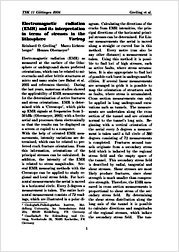| dc.contributor.author | Greiling, Reinhard O. | |
| dc.contributor.author | Lichtenberger, Marco | |
| dc.contributor.author | Obermeyer, Hennes | |
| dc.contributor.editor | Philipp, Sonja | |
| dc.contributor.editor | Leiss, Bernd | |
| dc.contributor.editor | Vollbrecht, Axel | |
| dc.contributor.editor | Tanner, David | |
| dc.contributor.editor | Gudmundsson, Agust | |
| dc.date.accessioned | 2010-11-26T13:21:16Z | |
| dc.date.accessioned | 2013-01-28T10:20:56Z | |
| dc.date.available | 2010-11-26T13:21:16Z | |
| dc.date.available | 2013-01-28T10:20:56Z | |
| dc.date.issued | 2006-03 | |
| dc.identifier.citation | Philipp, S.; Leiss, B; Vollbrecht, A.; Tanner, D.; Gudmundsson, A. (eds.): 11. Symposium "Tektonik, Struktur- und Kristallingeologie"; 2006, Univ.-Verl. Göttingen, p. 70 - 72. | |
| dc.identifier.isbn | 3-938616-40-7 | |
| dc.identifier.uri | http://hdl.handle.net/11858/00-1735-0000-0001-3434-3 | |
| dc.description.abstract | Electromagnetic radiation (EMR) as
measured at the surface of the lithosphere
or underground shows preferred orientations, which can be related to microcracks
and other brittle structures at
micro and nano scales (see Bahat et al.
2005 and references therein). During
the last years, numerous studies showed
the applicability of EMR measurements
for the determination of active fractures
and stress orientations. EMR is determined
with a ‘Cerescope’, which picks
up EMR signals at frequencies from 5–
50 kHz (Obermeyer, 2005) with a ferrite
aerial and processes them electronically
so that the results can be displayed on
a screen or copied to a computer.
With the help of oriented EMR measurements,
intensity variations are determined,
which can be related to preferred
crack fracture orientations. From
this information, orientations of the
principal stresses can be calculated. In
addition, the intensity of the EMR
is related to stress magnitudes... | |
| dc.format.mimetype | application/pdf | |
| dc.language.iso | deu | |
| dc.publisher | Universitätsverlag Göttingen | |
| dc.relation.ispartof | 11. Symposium "Tektonik, Struktur- und Kristallingeologie" | |
| dc.subject.ddc | 551 | |
| dc.subject.gok | TQD 000 | |
| dc.subject.gok | VAE 120 | |
| dc.subject.gok | VAE 150 | |
| dc.subject.gok | VAE 140 | |
| dc.title | Electromagnetic radiation (EMR) and its interpretation in terms of stresses in the lithosphere | |
| dc.type | anthologyArticle | |
| dc.subject.gokverbal | Elektrische Verfahren {Geophysik} | |
| dc.subject.gokverbal | Methodik {Strukturgeologie} | |
| dc.subject.gokverbal | Strukturelle Erscheinungen {Strukturgeologie} | |
| dc.subject.gokverbal | Gesteinsdeformation {Strukturgeologie} | |
| dc.bibliographicCitation.firstPage | 70 | |
| dc.bibliographicCitation.lastPage | 72 | |
| dc.identifier.doi | 10.23689/fidgeo-1916 | |
| dc.type.version | publishedVersion | |
| dc.subject.free | Lithosphäre | |
| dc.subject.free | Fraktographie | |
| dc.subject.free | Spannungstensor | |
| dc.subject.free | Elektromagnetisches Verfahren | |
| dc.relation.collection | Geologische Wissenschaften | |
| dc.description.type | conference | |


